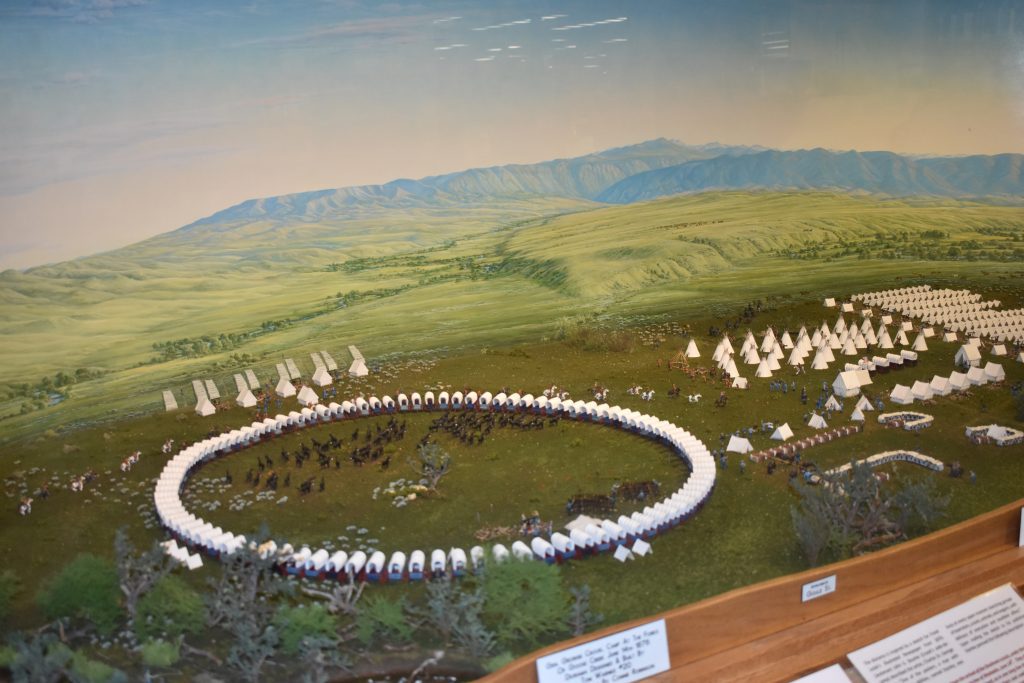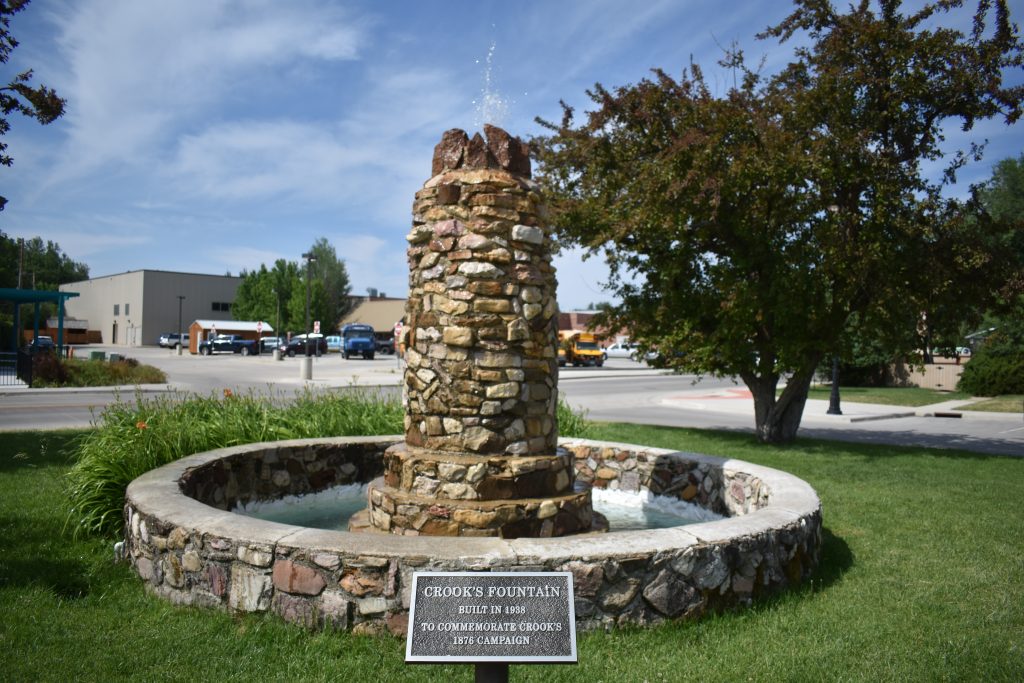News
General Crook Camps in Sheridan in 1876

Old drawing showing Generals Wesley Merritt, Philip Sheridan, George Crook, James William Forsyth, and George Armstrong Custer around a table examining a document. Thanks to Wyoming Room, Sheridan Fulmer Public Library.
On 28 May 1876, Civil War Brigadier General George Crook, under the command of General Phil Sheridan, assumed direct command of the Bighorn and Yellowstone Expedition at Fort Fetterman, near present-day Douglas.
In the March 11, 1876 Wyoming Weekly Leader
Small, Ames & Appel shipped during this past week, 140,000 pounds of freight, J. D. May 75,000 pounds and M. Appel. 40,000 pounds, all of which went to Fort Fetterman and consisted of supplies for General Crook’s expedition.
On May 29, Crook gathered a strong force from his Department of the Platte, and they left Fort Fetterman on May 29.
Crook ordered his entire force to prepare for a quick march. Each man was to carry only 1 blanket, 100 rounds of ammunition, and 4 days’ rations. The wagon train would be left at Goose Creek, and the infantry would be mounted on the pack mules.

From a July 8 Wyoming Weekly Leader, the correspondent describes the trip from Fort Fetterman to the Goose Creek Camp.
IN CAMP ON GOOSE CREEK, Wyoming, June 20, 1876,
To one of nervous temper, military movements are always slow, in fact just in time to be too late. This will be understood when I tell you that rapid as the marches were, it was full five days after “striking tents” opposite Fort Fetterman on the Platte before we sighted the Powder and the ruins of Old Fort Reno.
The trail for a short distance to the north swung clear of the famous Bozeman road, in the early days of this part of the Territory so much frequented by the emigrants and freighters and troops bound for Montana and the northwestern posts. Now all has changed.
Reno is a ruin. Kearney is a few blackened stakes. Smith is only a name of the past. And General Crook’s expedition is doing again the work which was undertaken in 1866 and undone in 1868. It is Crow land, indeed, but a heritage and a possession from accepting which all have shrunk back, and even the hardy frontiersman and adventurous prospector, in journeying towards the great northwest have followed the one of the olden time and “passed by on the other side.”
In the book, The Plainsmen of the Yellowstone, (Mark H. Brown, Bison Books, 1969)John Finerty, correspondent representing the Chicago Times wrote about the trip north. He noted that the army was joined by 75 miners, en-route to the Black Hills. He said during the skirmishes with the Sioux, the miners proved themselves cool, effective troopers. Finerty as well, proved himself an excellent fighter as well as a writer.
Crook decided on the junction of Big and Little Goose Creeks for his main camp. The Goose Creek area had everything an army would need. A fairly flat area to put the tents and wagons and Indian lodges, grass and water for the horses and mules.
Finerty also recorded that, while camped at Goose Creek waiting for their Indian allies, the men spend the leisure time, each according to his tastes. Crook, he said, hunted for butterflies and unusual birds; the miners went prospecting; a lieutenant and one of the packers turned to sketching. One of the packers was named Charles St. George Stanley, did many sketches of teamsters, scouts, and the camp.
From the Goose Creek Camp, Crook’s scouts gave him information about a war party of Sioux not far from his camp on Goose Creek. Crook left Goose Creek in pursuit of the Indians.

Weekly Leader, June 10, 1876
SAUCY SITTING BULL..
Sitting Bull, with the principal portion of his warriors, when last heard from through agency Indians, was somewhere near the mouth of Powder River. Reinforced by ….Arapahoes, Cheyennes, Mandans and large numbers of young (warriors) from the Red Cloud and Spotted Tail agencies…. He is, or soon will be, joined by Crazy Horse with over 200 warriors. Little Bad Man, with about the same number, and the agency Indians joining, closely approximated at 900, swell the great northern force to at least 2,000 young braves. Acting independently or together, these bands could easily arrange to out-number Crook’s force, and should the two northern columns of troops under Generals Terry and Gibbon not arrive at the scene very soon, this command will have its hands very full.,
At the Battle of the Rosebud, Crook’s troops did indeed have their hands full. The Rosebud battlefield is surrounded by rough, red shale rock ridges, and the Indians attacked from above. Both sides tried to gain the advantage of the hill tops, but neither side could get an advantage, and the battle was considered a draw, and Crook withdrew back to the Goose Creek Camp.
Wyoming Weekly Leader June 17, 1876
Why Crook is Not Heard From. “Our people are anxiously awaiting news from the Crook expedition, and we are constantly assailed with queries as to why the gallant General is not heard from. We are becoming very impatient ourselves, and have therefor gleaned from parties who know the country through which the Big Horn expedition is now traveling, the reasons for this long continued and painful silence regarding the progress of the expedition. ‘The route taken by General Crook from Fort Fetterman north leads through a country admirably adapted for the picking off of stragglers or couriers, for whom (The Indians) wait day and night. This being the case, and General Crook not having a single man with him whose presence can be dispensed with when it is almost an absolute certainty that his life will be taken before he (can reach) safety, it is no wonder that no couriers have yet been sent back to inform a waiting country of the movements of the command.
One can, today, drive from Fort Fetterman to the Rosebud Battlefield, and except for a few houses, power lines and highways, the land is very much the same as it was when Crook’s troops rode the trails. The rough, rugged landscape made it easy for the Indians, who knew the land, to hide and pick off the lone riders. And, Crook knew every man was needed.
Later, the readership heard from Crook’s troops.
Wyoming Weekly Leader
IN CAMP, ROSEBUD CREEK, 1 MONTANA , June 17. / (Via Fort Fetterman June 23.)
We have met the Indians and after a hard fought battle, are now camped on the scene of carnage, having repulsed the foe. The command left the wagon train yesterday morning at our late camp on Goose Creek, and marched down the Rosebud, expecting to strike the Sioux at its mouth. After marching a few miles this morning, shots were heard in advance and soon a few small bands of Sioux were seen on the high bluff’s above the narrow and high walled valley in which the command had halted…
We regret that the news conveyed to our readers through the leader from Gen. Crook’s command, is not as encouraging as we anticipated. Our correspondent gives the result as “a drawn battle,” after several hours of hard fighting.
It must be admitted that the Sioux will fight, and that they are bold enough to attack, when permitted to choose their ground. Our boys in blue fought well and kept their ground, the Indians retiring from the field. The article went on to say that the Indian losses were unknown.
However, on an information sign at the Rosebud Battlefield, these following statistics were reported: Crooks force, 1329, included 978 Cavalry and Infantry; 176 Crow warriors; 86 Shoshone warriors; 65 Montana prospectors and 20 packers. There were also five correspondents and reporters listed at the camp. After the battle Crook’s dead was nine soldiers, one Indian scout, and eight Crow and Shoshone.
They estimated that the Indians under Crazy Horse had 1200 warriors, Sioux, Northern Cheyenne and Arapahoe. The estimates of Indians killed were 25 Sioux and five Northern Cheyenne.
The Cheyenne called the Rosebud Battle the “Fight Where the Girl Saved Her Brother.” Buffalo Calf Road Woman, a Cheyenne, saw her brother, Comes-In-Sight, fall when his horse was shot out from under him. She jumped on her own horse and rode through the bullets to rescue her brother. He jumped on the back of her mount and they raced to safety. Ten days later she fought beside her husband, Black Coyote, at the Battle of the Little Big Horn.

After the battle, which was pretty much a draw, the Wyoming Weekly Leader said this……Gen. Crook is reported to have retired to his old camp on Goose Creek, for the purpose of getting fresh supplies and ammunition; he will therefore soon be able to renew the fight, if the Sioux remain in that vicinity. Gen. Terry’s and Gen. Gibbon’s commands must be within a few day’s march of the battle field, and they will undoubtedly join Gen. Crook in a combined attack upon the Indian stronghold on the Rosebud. The village which was in sight of our brave soldiers when fighting Sitting Bull’s warriors, is doomed; the great battle of this summer’s campaign will be fought soon, if it has not already taken place. The date on this article was June 23. Three days later, Custer attacked the Sioux at Little Big Horn.
Crook could have continued to pursue the Sioux after the Rosebud battle, but his scouts said there were too many places for the Cavalry to be ambushed, so Crook withdrew back to Goose Creek.
In 1938, a stone fountain, called Crook’s Fountain, was built near the junction of Big and Little Goose Creeks to commemorate Crook’s camp there. An interpretive sign with information about the camp is there as well.
There is diorama of the camp in the Wyoming Room at the Sheridan Fulmer County Library, based on sketches by Charles St. George Stanley, the packer who did many sketches of army life on the plains.

At the Rosebud Battlefield, which is a National Historic Landmark, and a Montana State Park, there are interpretive signs about the battle.
There is speculation, even today, what might have happened had Crook continued his pursuit. Perhaps, some historians feel, Crook could have been at the Little Big Horn at the critical time, and the battle may have turned out very differently. But, we will never know what might have been.


David John BELD
July 3, 2021 at 11:21 pm
That was a very good historical article about General Crook and his men, before Sheridan was even established in 1882!!!!